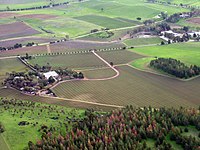
Photo from wikipedia
Abstract Objectives Some factors influence the experience of the COVID‐19 pandemic (health, loneliness, digital access...), but what about the living area? The objective was to compare between rural and urban… Click to show full abstract
Abstract Objectives Some factors influence the experience of the COVID‐19 pandemic (health, loneliness, digital access...), but what about the living area? The objective was to compare between rural and urban areas, the psychological and social experiences of the older individuals with regard to the COVID‐19 crisis during the first French lockdown. Methods The sample included participants of three existing population‐based cohorts on aging. Telephone interviews conducted by psychologists focused on the lockdown period. Data collected included living environment, professional assistance, social support, contacts with relatives, difficulties encountered, health, and knowledge and representations of the epidemic. The negative experience was defined by the presence of at least two of the following items: high anxiety symptomatology, depressive symptoms, worries or difficulties during the lockdown and insufficient social support. Results The sample included 467 participants, aged on average 87.5 years (5.2), 58.9% were female and 47.1% lived in rural areas. Persons living in rural area had better social support, greater family presence, a less frequent feeling of imprisonment (OR = 0.60, 95 CI% = 0.36‐0.99), 95% had a garden (vs. 56%), fewer depressive symptoms and lower anxiety scores, but also tended to lower comply with the health measures. Finally, they had an almost twofold lower risk of having a negative experience of the lockdown compared to their urban counterparts (OR = 0.55, 95% CI = 0.33–0.92, p = 0.0223). Conclusions The oldest old living in rural area experienced the first lockdown better than the urbans. Living conditions, with access to nature, a greater social support and family presence, could have contributed to these findings.
Journal Title: International Journal of Geriatric Psychiatry
Year Published: 2021
Link to full text (if available)
Share on Social Media: Sign Up to like & get
recommendations!